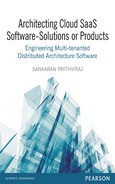Contents
1.1 SaaS Deployed and Provided from Cloud Environment
1.3 ‘Software Architecting’ is Different from ‘Software Designing’
1.4 TOGAF, ABBs, SBBs and Building Blocks
1.5 Cloud SaaS – An Evolution and SaaS Business Models
1.5.2 Conventional, On-Premise Installed Model
1.5.4 Cloud Model: (SaaS Provided from Cloud Environment)
1.6 SaaS Provided from Cloud Environment vs Hosted Model
1.7 Enterprise Models for SaaS Consumption
1.7.1 Modelling Enterprises (for the Sake of Providing Solutions)
1.7.2 Bigger Enterprises and Verticals
1.7.3 Small- and Medium-sized Enterprises
2 Architecting Methods for Cloud SaaS Software – Solutions or Products
2.2 Cloud SaaS Solution Addressing Business Capabilities of SMEs
2.3 Adopting TOGAF’s ADM Phases for Cloud SaaS Solution
2.3.1 Phases – Preliminary Phase to Phase A–D
2.3.2 Phase E: Opportunities and Solutions
2.4.1 Requirements Collection and Identification of ABBs
2.4.2 Architecting by Employing Techniques from TOGAF
3 How Do Hypervisors Work? How Does IaaS Function?
3.5 Scaling through Software Architecture or Hardware
3.6 Motivation or Need for Scalable Architecture
3.7 Scalable Architecture (of Software)
3.10 Summary of Capabilities of Hypervisors
3.11 A Simple Model of Infrastructure as a Service (IaaS)
4 Architecting Software Solutions for Public IaaS Cloud (without SaaS)
4.2.1 Identifying Minimum Deployment Hardware Configuration for each SBB
4.2.2 Calculating IaaS Infrastructure Configuration
4.3 Digital Communication Platform
4.5 Realization of the Envisaged Solution Architecture
4.6 Architectural Considerations
4.7 Mapping Deployment Architecture into Public IaaS Cloud
5 Characteristics of Cloud SaaS Software
5.3.1 Web Tier: User Interface
5.3.5 Abilities to Choose Functions at Fine Granular Level
5.4 Scaling (Auto-Scaling and Auto-Provisioning)
5.5 Operational and Billing Support Services
5.6 Software Upgrades and Maintenance
5.9 SaaS Architecture is Unique
6.2 Motivation to Come Up with Cloud Compatibility Measure
6.3 Definition of ‘Cloud Compatibility’
6.4 SaaS (Solutions) Maturity Model
6.5 SaaS Maturity Continuum Scale
6.6 Cloud Compatibility Measure
6.6.1 Procedure to Set Up the ‘Cloud Compatibility Measuring Scale’
6.6.2 Ideal Values for Characteristics
6.6.3 Case Study – Measures for Two Products of Similar Functionalities
6.7 Combined Discussion about All the Three ‘Cloud Compatibility Measures’
7 Architecting SaaS Solutions for Cloud Using Semi-Cloud Compatible SBBs
7.2.1 Introduction to Case Study
7.2.4 Solutions Implications and Constraints
7.3.1 Building Business Capabilities for a Group of Enterprises
7.3.2 Calibrating COTS against Cloud Compatibility Criteria
7.3.3 Key Challenges and Solutions in Finalizing SBBs
7.3.4 Security Requirements and Solutions to the Final Solution
7.4 Summary of Cloud-Based SaaS Solution
7.4.1 Deployment Architecture for Minimum Usage
7.4.2 Evolving Deployment Architecture
7.4.3 Size Software for Scalability
7.4.4 Determining Scaling Algorithms
7.5 Other Routine Steps for Implementing the Solution
7.6 Less Cloud-Ready Software Costs More for Per-User/Time
8 Architecting Cloud SaaS Solutions with Cloud Non-Compatible Products
8.2 Classification of Solutions Using Not-at-All Cloud Compatible Products
8.4.3 Some Common Observations
9 Architecting Cloud Compatible SaaS Software Products
9.2 Cloud SaaS Product Architecture Development Methodology
9.3 Drivers Influencing Architecture of Cloud SaaS Products
9.4 Characteristics Required for Cloud-SaaS-Products’ Architecture
9.5 Selection of Basic Architecture for Cloud Compatible SaaS Product
9.6 Starting Points for Architecting Projects
9.6.1 Starting from CCRA for SaaS
9.6.2 Starting from Functional Requirements of Cloud SaaS Product
9.7 Distributed Applications Architecture
9.7.1 Tier-Wise Specific Points Relevant to Architecture of Cloud SaaS
9.7.2 Architecting to Scale the Application
9.7.3 Service Orientation of Entire Product Architecture
9.8 Identity and Access Management
9.9 Transaction-less vs Transaction-intensive Products
9.11 Infrastructure Softwares’ Architectures for SaaS Solutions
9.12 Deployment Architecture Basics for Cloud SaaS Products
10 Cloud Computing Reference Architecture
10.1.2 What Does CCRA Bring to Table for Solution Architects?
10.2 Cloud Computing Architectures Are Service-Oriented Architectures
10.2.1 Important Aspects of Cloud (SaaS) Services
10.2.2 Cloud Reference Architecture Derives Experience from SOA in Addressing these Aspects
10.3 A Quick Summary of the SOA RA
10.4 Using the SOA RA with the CCRA
10.5 CCRA – Architecture Overview Diagram
10.5.2 Architectural Elements for Each of These Three Major Roles
10.6 Architectural Principles and Related Guidance
10.7 Comparison of CCRAs of IBMTM, MicrosoftTM and HPTM[25]
11 Architecting for Security in Cloud SaaS Software
11.3 Security Architecture for Cloud SaaS
11.5 Building Security within SaaS Software: Some Implementation Tips
